Altoona, PA was the halfway point for our trip to Ohio. Altoona was first settled by white men in the mid 1700s when Stockades were built, including Fort Roberdeau (1778) during the American Revolutionary War. In 1849 the Allegheny Portage Railroad was founded to transport lumber and coal, leading to growth of the city, which became incorporated in 1868.
In late September 1862, Altoona was home to the War Governors' Conference which brought together 13 governors of Union states. This body gave early approval to the Emancipation Proclamation.
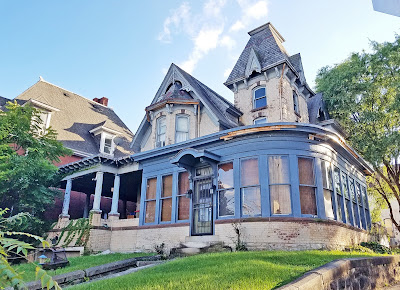 |
| 903 Lexington Avenue certainly has an eclectic mixture of architectural styles |
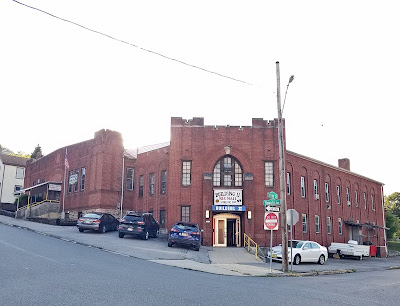 |
| 1000 Howard Avenue is the former Howard Avenue Armory (1938) |
 |
| 1108-1110 14th Avenue with Victorian-style porch |
 |
| 1109 14th Avenue in Queen Anne style |
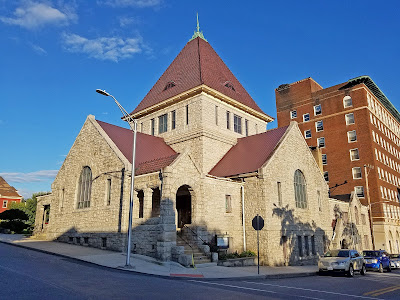 |
| First United Presbyterian Church (1897–1898, by William J East, 1926 addition, by George Espie Savage in Richardsonian Romanesque style) at 1314 12th Street |
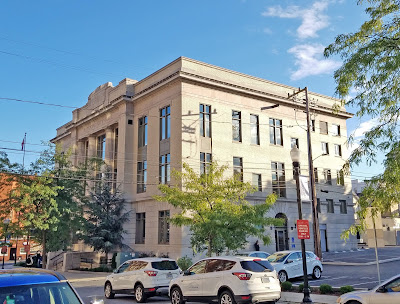 |
| Altoona City Hall (1925-1927, by Frederic Sholler and Frank Hersh in Beaux Arts style) |
 |
| Portal of City Hall (the dappling is reflection of light off windows of the building across the street) |
 |
| Tom & Joe's Restaurant opened in 1933 across the street and moved to this building in 1950 |
 |
| Texas Hot Dogs (1918) is said to be the oldest hot dog stand in Pennsylvania; located at 1122 12th Avenue, it was even visited by President Barack Obama |
 |
| Inside Texas Hot Dogs |
 |
| Texas Macaroni and Texas Hot Dogs with its unique chili sauce; a hot dog with everything means chili, brown mustard, and freshly chopped onions |
 |
| Texas Macaroni has melted cheese and chili sauce |
 |
| Altoona Trust Company (1901-1902, by Mowbray and Uffinger) at 1128-1130 12th Avenue, was the first Classical Revival style building in downtown Altoona |
 |
| Just happened to notice the Thompson Pharmacy at 1118 12th Street |
 |
| Mishler Theater (1906, by Albert E Westover in Beaux Arts style) at 1211 12th Avenue, has statues of Terpsichore and Melpomene, the muses of song and dance, and tragedy |
 |
| First Methodist Episcopal Church (1905-1907, by M R Brown in Hummelstown brownstone) at 1208 13th Street |
 |
| Cathedral of the Blessed Sacrament (1924–1931, by George Ignatius Lovatt, Sr in Renaissance Revival style) at 1 Cathedral Square |
 |
| McCrory's Building (1937 in Art Moderne style) at 1306 11th Avenue |
 |
| Central Trust Company Building (1905–1906, by Charles M Robinson and George Winkler with a Romanesque Revival façade) at 1218 11th Avenue |
 |
| Former Brett Department Store (1922–1924, by Julian Millard) at 1216 11th Avenue |
 |
| First National Bank (1924–1926, by John A Dempwolf in Neoclassical style) at 1206 11th Avenue |
 |
| Silverman Building (1924-1925, in Neoclassical style) at 1200-1204 11th Avenue |
 |
| US Post Office (1931–1933, by James A. Wetmore with with David A Royer and Ronald C Anglemyer in Neoclassical and Art Deco styles) |
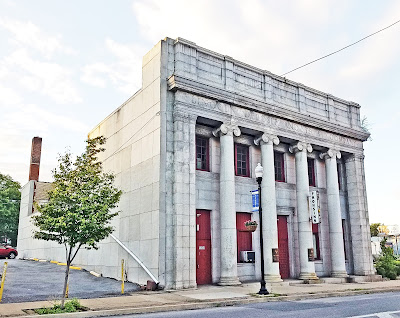 |
| Lincoln Trust Company Building in Neoclassical style) |
 |
| George Rudisill House (by Louis Beezer and Michael J Beezer in Queen Anne style) at 1111 12th Avenue |
 |
| Parklet at Masonic Temple Building |
 |
| Masonic Temple Building (1899-1890, by James H Windrim) at 1111-1119 11th St |
